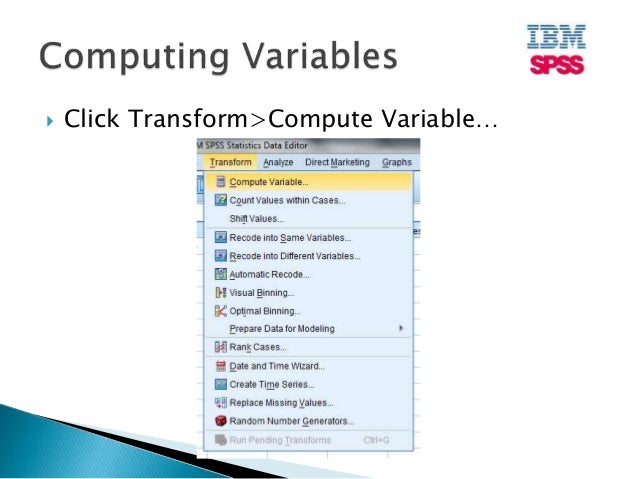How To Use Spss Software
The developers of IBM SPSS Statistics have made every effort to make the software easy to use. SPSS prevents you from making mistakes or even forgetting something. That’s not to say it’s impossible to do something wrong in SPSS, but the SPSS software works hard to keep you from running into the ditch. To foul things up, you almost have to work at figuring out a way of doing something wrong.
The IBM SPSS® software platform offers advanced statistical analysis, a vast library of machine-learning algorithms, text analysis, open-source extensibility, integration with big data and seamless deployment into applications. Installation Instructions. Install the IBM SPSS Statistics file you downloaded from software.usc.edu/spss. The installer should begin running. On the IBM SPSS Statistics – InstallShield Wizard screen, click Next. On the Software License Agreement screen, read the terms and choose I accept the terms in the license agreement, then click Next.
SPSS means “Statistical Package for the Social Sciences” and was first launched in 1968. Since SPSS was acquired by IBM in 2009, it's officially known as IBM SPSS Statistics but most users still just refer to it as “SPSS”. SPSS - Quick Overview Main Features. SPSS is software for editing and analyzing all sorts of data. These data may. 8 SPSS Step-by-Step Try it: 1. From the menu, select Analyze Descriptive Statistics Crosstabs. Click once on Employment, then click the small right arrow next to Rows to move the variable to the Rows pane (Figure 1). Moving a variable to the Rows pane 3. Click Gender, then click the small right arrow next to Columns to move the. Aug 02, 2016 In this video you will learn to make entries in 'variable view' tab.
You always begin by defining a set of variables; then you enter data for the variables to create a number of cases. For example, if you’re doing an analysis of automobiles, each car in your study would be a case. The variables that define the cases could be things such as the year of manufacture, horsepower, and cubic inches of displacement. Each car in the study is defined as a single case, and each case is defined as a set of values assigned to the collection of variables. Every case has a value for each variable. (Well, you can have a missing value.)
Each variable is a specific type. Types describe how the data is stored — for example, as letters (strings), as numbers, as dates, or as currency. Each variable is defined as containing a certain kind of number, so you also have to define the variable’s level of measurement.
For example, a scale variable is a numeric measurement, such as weight or miles per gallon. A categorical variable contains values that define a category; for example, a variable named gender could be a categorical variable defined to contain only values 1 for female and 2 for male. Things that make sense for one type of variable don’t necessarily make sense for another. For example, it makes sense to calculate the average miles per gallon, but not the average gender.
After your data is entered into SPSS — your cases are all defined by values stored in the variables — you can easily run an analysis. You’ve already finished the hard part. Running an analysis on the data is simple compared to entering the data. To run an analysis, you select the analysis you want to run from the menu, select the appropriate variables, and click OK. SPSS reads through all your cases, performs the analysis, and presents you with the output as tables or graphs. Of course, you have to know which analysis to choose.
The most obvious use for SPSS is to use the software to run statistical tests. SPSS has all of the most widely used statistical tests built-in to the software. Therefore, you won't have to do any mathematical equations by hand. Once you run a statistical test, all associated outputs are displayed in the data output file. IBM SPSS Statistics is software for managing data and calculating a wide variety of statistics. This document is intended for students taking classes that use SPSS Statistics or anyone else who is totally new to the SPSS software. Those who plan on doing more involved research projects using SPSS should follow up this brief intro with more in.
You can instruct SPSS to draw graphs and charts directly from your data the same way you instruct it to do an analysis. You select the desired graph from the menu, assign variables to it, and click OK.


When you’re preparing SPSS to run an analysis or draw a graph, the OK button is unavailable until you’ve made all the choices necessary to produce output. Not only does SPSS require that you select a sufficient number of variables to produce output, but it also requires you to choose the right kinds of variables. If a categorical variable is required for a certain slot, SPSS won’t allow you to choose any other kind of variable. Whether the output makes sense is up to you and your data, but SPSS makes sure that the choices you make can be used to produce some kind of result.
How To Use Spss Software Video
All output from SPSS goes to the same place — a dialog box named SPSS Statistics Viewer. This dialog box displays the results of whatever you’ve done. After you’ve produced output, if you perform some action that produces more output, the new output is displayed in the same dialog box. And almost anything you do produces output.